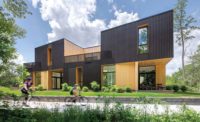Boston
Elizabeth Whittaker, the principal of Merge Architects, doesn't take rejection personally. Working in Boston—a city that has historically lacked an appetite for contemporary architecture—Whittaker is constantly told "It can't be done." So she and her staff of four often take matters into their own hands.
One recent project—a 2,800-square-foot, state-of-the-art orthodontics clinic in Waltham, Massachusetts—is a case in point. The project involved a complicated gut renovation of a crumbling 100-year-old warehouse building. When the general contractor looked at the drawings for the centerpiece of the design—a curving 20-foot-high translucent wall made of wood and polycarbonate—he balked. "He said, 'There's no way I can do this; we don't have the budget,' " Whittaker recalls. "But, when I got up on a ladder, I realized we could make it happen." After the pieces were fabricated off-site, she and her staff borrowed the contractor's equipment and spent a few weeks installing the wall themselves.
For Merge, this is business as usual. "I started my firm because, first and foremost, I wanted to build," says Whittaker, 46, who graduated from the Harvard Graduate School of Design in 1999 and spent three years working for Boston firms before starting her own practice in 2003. The firm frequently makes its own pieces for projects, designing and assembling everything from a hand-stitched felt light fixture above the reception desk in the orthodontics office to a wall adorned with thousands of woven cotton straps for a Nepali/Indian restaurant.
Whittaker's obsession with details and craftsmanship often underlies a project's design concept. She has created a series of interiors based on unassuming items—stacking more than 1,500 water bottles into a wall for a health spa, for example, or inserting 42,000 wooden dowels into an undulating pegboard wall partition in a loft. "I'm interested in taking simple objects—reinventing them, abstracting them, giving them a new scale or even scalelessness," says Whittaker.
Details are elements she finds worth fighting for. Merge recently completed its second multifamily project—a nine-unit, 12,000-square-foot apartment complex next to a shipyard in East Boston. "It's on the waterfront, where there's very little greenery or vegetation," Whittaker says. Merge designed it with a vertical garden on the facade: metal-mesh screens, planted with vines and honeysuckle, frame each unit. But whenever budget concerns arose, the mesh was the first thing targeted to go. "I had to fight over and over again for that mesh facade, even though it was a very small percentage of the overall budget," she says. "But I knew how important it was to get the vertical garden for the neighborhood, for that corner, for the new residents." Ultimately, the developer signed off. Now that the building is complete, Whittaker says she's gotten several phone calls from developers asking how she did it.
The payoff of Whittaker's persistence shows in her direct involvement in the fabrication and construction process. It is the reason, she believes, why the projects come in on budget, and sometimes why they are built at all. "The mesh, and things like that, would never survive unless we shouted for it," Whittaker says. "We're involved to the bitter end."
Merge Architects
FOUNDED: 2003
DESIGN STAFF: 5
PRINCIPALS: Elizabeth Whittaker
EDUCATION: Harvard GSD, M.Arch., 1999; North Carolina State University, bachelor's, 1991
WORK HISTORY: Brian Healy Architects, 1999-2003; Edwardt & Lattermann, 1996-97; Gehry Partners, 1995; Dean/Wolf Architects, 1991-92; Edward I. Mills + Associates, 1991-93
KEY COMPLETED PROJECTS: Marginal Street Lofts, East Boston, 2014; Northeastern University Alumni Building Lobby/Caf', Boston, 2014; MIT Beaver Works, Cambridge, MA, 2013; Lightwell-Greater Boston Orthodontics, Waltham, MA, 2013
KEY CURRENT PROJECTS: MiniMed Health Clinics, Panama City, Panama, 2012-present; Grow Box, Lexington, MA, 2015; Fort Hill Townhouses, Roxbury, MA, 2015
WEBSITE: WWW.MERGEARCHITECTS.COM
People |
Products |

















Post a comment to this article
Report Abusive Comment